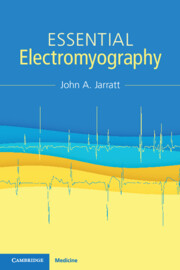Book contents
- Essential Electromyography
- Essential Electromyography
- Copyright page
- Dedication
- Contents
- Figures
- Diagrams
- Tables
- Preface
- Acknowledgements
- Abbreviations
- Chapter 1 Introduction
- Chapter 2 Basic Anatomy and a Little Physiology
- Chapter 3 Peripheral Nerve Types
- Chapter 4 Peripheral Nerve Function
- Chapter 5 The Neuromuscular Junction
- Chapter 6 Muscle
- Chapter 7 Some Technical Matters: Electrodes, Stimulators, Amplifiers, Display, Averagers
- Chapter 8 Volume Conduction
- Chapter 9 Pathology
- Chapter 10 Electromyography (EMG)
- Chapter 11 Nerve Conduction Studies (NCS): Introduction
- Chapter 12 Nerve Conduction Studies: Normal
- Chapter 13 Nerve Conduction Studies: Degeneration
- Chapter 14 Nerve Conduction Studies: Demyelination
- Chapter 15 Degree of Pathology
- Chapter 16 Tests of Neuromuscular Transmission
- Chapter 17 Other Techniques: F-waves and H-reflexes
- Chapter 18 Clinical Applications
- Chapter 19 Other Stuff: Aberrant Nerve Pathways, A-waves, EMG Anomalies
- Chapter 20 Normal Values
- Chapter 21 Conclusion
- Glossary
- Further Reading
- Index
Chapter 16 - Tests of Neuromuscular Transmission
Published online by Cambridge University Press: 14 September 2023
- Essential Electromyography
- Essential Electromyography
- Copyright page
- Dedication
- Contents
- Figures
- Diagrams
- Tables
- Preface
- Acknowledgements
- Abbreviations
- Chapter 1 Introduction
- Chapter 2 Basic Anatomy and a Little Physiology
- Chapter 3 Peripheral Nerve Types
- Chapter 4 Peripheral Nerve Function
- Chapter 5 The Neuromuscular Junction
- Chapter 6 Muscle
- Chapter 7 Some Technical Matters: Electrodes, Stimulators, Amplifiers, Display, Averagers
- Chapter 8 Volume Conduction
- Chapter 9 Pathology
- Chapter 10 Electromyography (EMG)
- Chapter 11 Nerve Conduction Studies (NCS): Introduction
- Chapter 12 Nerve Conduction Studies: Normal
- Chapter 13 Nerve Conduction Studies: Degeneration
- Chapter 14 Nerve Conduction Studies: Demyelination
- Chapter 15 Degree of Pathology
- Chapter 16 Tests of Neuromuscular Transmission
- Chapter 17 Other Techniques: F-waves and H-reflexes
- Chapter 18 Clinical Applications
- Chapter 19 Other Stuff: Aberrant Nerve Pathways, A-waves, EMG Anomalies
- Chapter 20 Normal Values
- Chapter 21 Conclusion
- Glossary
- Further Reading
- Index
Summary
Clinical examples of normal results obtained during repetitive nerve stimulation are given. These are followed by illustrations of the findings obtained from patients with myasthenia gravis or myasthenic syndrome. The different underlying pathophysiologies are discussed. A clinical case of pseudofacilitation is also included. The principles underlying the technique of voluntary single-fibre electromyography are described. Diagrams are also included to show how jitter measurements are made and how these are increased in neuromuscular transmission disorders. In severe cases transmission may fail, so-called blocking. Good clinical examples are included of normal jitter and of increased jitter with blocking.
Keywords
- Type
- Chapter
- Information
- Essential Electromyography , pp. 72 - 81Publisher: Cambridge University PressPrint publication year: 2023

